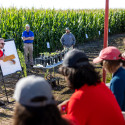University Housing builds for the next generation
Mark Roessler remembers the day he took his 10-year-old son Trevor on a guided tour of Newell J. Smith Residence Hall.
The pair walked through the gleaming, nearly completed building on Park Street, just north of Regent Street, before stopping in a large room with a panoramic view.
“Trevor says to me: ‘This is the one that I want for my bedroom,’” he recalls.
“That’s what I love about my job,” says Roessler, assistant director of residence halls facilities capital projects in University Housing.
“I help build buildings for the next generation — buildings that will last for the next 40 to 70 years. They’re buildings that my son and his friends could live in when they come here for college.”

Mark Roessler, assistant director of residence halls facilities capital projects in University Housing, stands in front of unfinished drywall in the future 425-bed Newell J. Smith Residence Hall. The new residence hall on Park Street, named for former University Housing director Newell J. Smith, is the first new major dormitory built on campus since 1965. Smith Hall and an adjacent office building will be completed in June.
Photo: Michael Forster Rothbart
Roessler serves as housing’s design and building guru, responsible for shepherding complex, multimillion-dollar construction projects from inception through design, approval, construction and finally, student move-in. The process involves hundreds of thousands, if not millions, of details, along with complex interactions with construction firms and state government.
Currently, Roessler is working on the final details of Newell J. Smith, a 425-bed hall named for the legendary former housing director who served between 1955-83. He’s also helping supervise construction at the new Ogg Hall located at Park and Dayton streets.
Before taking on his current duties in 2003, he worked in numerous “behind-the-scenes” jobs in housing, including stints as a mechanic, maintenance supervisor and facilities manager at several housing sites, including the Lakeshore residence halls and University Apartments.
He joined housing in 1979 and has served there ever since, with the exception of a brief stint with Physical Plant at the Charter Street Heating Plant.
“From a technical standpoint, working at the heating plant was probably the best job I ever had,” he says. “But I also learned that I love being around people, and I love being in housing.
“I think we leave a good impression on the people who stay with us,” he adds. “Providing a roof and food is one thing, but when students leave, they remember our staff. That speaks well of our organization.”
Roessler says he thrives on the constant juggling of projects and priorities involved in the capital process. The move to upgrade current residence hall facilities has been especially exciting, resulting from the need to replace Ogg Hall, which is outdated and will eventually be demolished.
To design the next generation of halls, housing surveyed its current students and took tours of new residence halls across the country. Ultimately, it was decided that students would live in an environment of “clusters,” in which two double rooms and one single room share a common bathroom. Designers took the step of forcing students to enter the hallway to use the bathroom to increase interaction among students.

Twice a week, Roessler (center) meets with Boldt Construction superintendent Mick Shaw (right) and project manager Eric Swanlund (left) to discuss construction issues.
Photo: Michael Forster Rothbart
The finished building will also feature a deli-style food service area, a kitchenette for each floor and, for the first time, air conditioning in each resident room.
Once the building design was completed, Roessler assisted in the process of gaining the approvals for the $36 million building, which included a complicated arrangement among Boldt Construction, the Division of State Facilities, the State Building Commission and UW Board of Regents.
“Building a residence hall is like building your own house, 50 times over,” says University Housing Director Paul Evans. “Mark is extremely good at taking on a complicated, large project and bringing it through the phases of design, approval and construction — all while maintaining good relationships with residents, the state and university. He gets it done.”
Through the construction process, Roessler and other staff members keep in close contact with construction managers, watching the quality, schedule and cost of work. In addition, problems sometimes arise and require troubleshooting.
“There are days when you put your head in your hands and wonder how you’re going to get through it,” he says. “But I’m happiest when I’m going at 90 miles per hour with my hair on fire.”
During the course of the next few months, housing will be granted access to the building floor by floor and will undertake an extensive cleaning effort. Once elevators are operational, furniture and other amenities will be added preparation for the return of hall staff in early August.
Even before the building is completed, Roessler may have had his best moment in the new building when he escorted the 87-year-old Newell Smith, a mentor of his and many other current employees, on a tour.
“I can’t tell you how touched I was to be able to do that,” says Roessler. “He thought the building was fantastic. And he knew that the whippersnappers who came after him had learned from him what housing was all about.”




